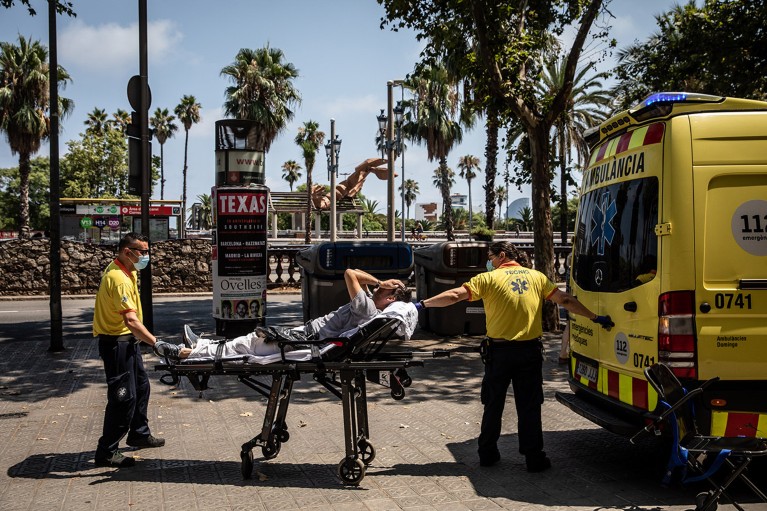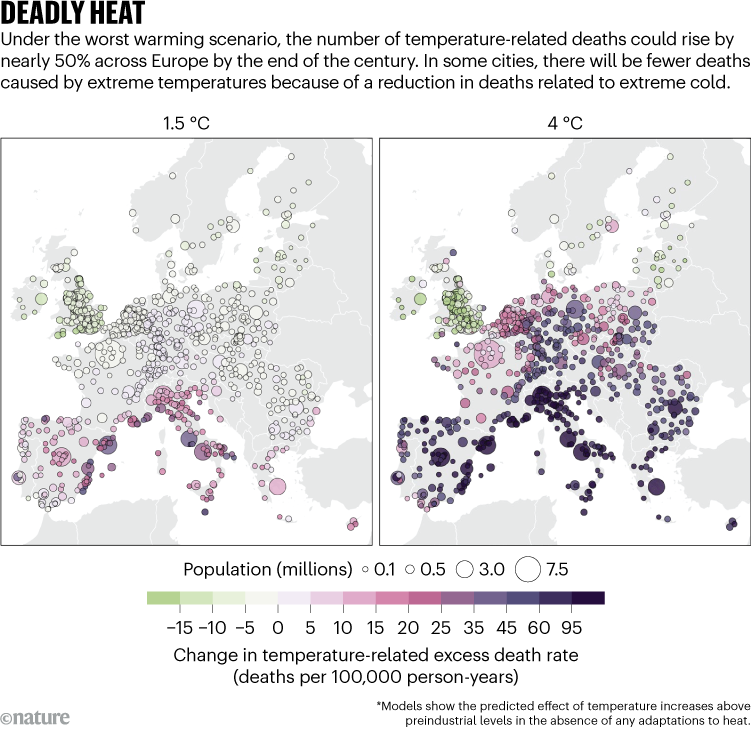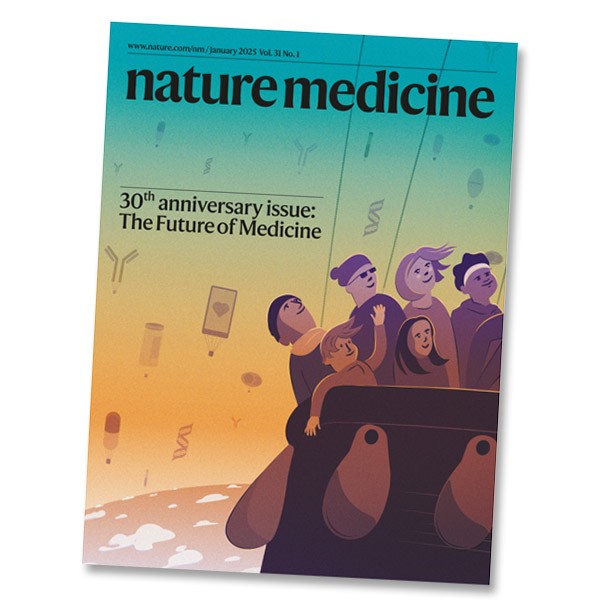Hello Nature readers, would you like to get this Briefing in your inbox free every day? Sign up here.

Paramedics help a person affected by heatstroke during a 2022 heatwave in Barcelona, Spain.Credit: Angel Garcia/Bloomberg via Getty
An extra 2.3 million people in European cities could die as a result of extreme temperatures — both hot and cold — by the end of the century if decision makers don’t act to mitigate climate change. Researchers analysed temperature and mortality data from urban areas in 30 European countries to model various warming scenarios and the possible temperature-related deaths associated with them between 2015 and 2099. The results suggest that heat-related deaths will surpass those caused by cold conditions in even the most optimistic scenarios, and that temperature-related deaths overall could increase by nearly 50%.
Nature | 4 min read
Reference: Nature Medicine paper

Source: Ref. 1Source: Ref. 1
At least 68 people in North America have become ill from the H5N1 avian influenza virus and one person has died. Most of these illnesses were mild, but emerging data indicate that variants of the virus can cause severe disease and death, especially when passed directly to people from birds. Researchers are monitoring two main variants – one carried mainly by birds and one carried mainly by cows – but the numbers of human infections are too small to determine whether one is more dangerous than the other. “If the virus has adapted to cows, it is also better adapted to go into human cells,” says evolutionary virologist Daniel Goldhill. “This is a first stepping stone for the virus — and it has increased the risk level of a virus jumping to humans.”
Nature | 6 min read
Features & opinion
Toca do Tatu — the Armadillo’s Den — is a spectacular cave in southern Brazil that might have been carved by generations of giant ground sloths. The ice-age megafauna went extinct more than 10,000 years ago. Large scratches on the walls and ceiling suggest, to some scientists, that the cave is the largest known example of an ‘ichnofossil’: a track, tunnel or other mark left by ancient organisms.
Nature | 9 min read

A reconstruction of several extinct ground sloths and armadillos compares them with the dimensions of some caves found in South America.Credit: Renato Pereira Lopes
Last year, a group of farmers took to the courts in an attempt to force the Swiss government to act on climate change before their farms become unviable. The case is yet to be settled, but lawsuits from farmers might have stronger sway with governments than previous climate cases from social activist groups, say three climate law experts, because agriculture holds a central role in Swiss politics. “A win would change the legal landscape for other cases in Europe, and potentially beyond,” the trio write. “The world cannot afford to leave farmers in climate limbo, just as farmers cannot afford to turn their backs to the changing climate.”
Nature | 8 min read
Gottfried Leibniz was a tireless polymath who covered ground in everything from philosophy to geology — as well as inventing versions of calculus and binary arithmetic. He also got the mickey ruthlessly taken out of his ‘best of all possible worlds’ religious philosophy in “the best of all possible parodies” — Voltaire’s Candide. In a rollicking overview of Leibniz’s life of relentless intellectual exploration, historian of thought Anthony Gottlieb says that the bewigged boffin “couldn’t stop dreaming up ways to make the world better”.
The New Yorker | 14 min read
Today I’m warming up to the idea of cutting my lawn in curves, instead of straight lines. ‘Meandering mowing lines’ and areas of uncut grass, as well as edges left free to flourish, leads to boosts in bee and butterfly diversity in just two years. The technique could reap big returns on farms, parks and maintained grasslands, but “everyone who has a yard can contribute”, say researchers.
While I fantasize about fostering a lush grassland in my backyard (rather than a muddy football pitch), why not send me your feedback on this newsletter? Your feedback is welcome at [email protected].
Thanks for reading,
Flora Graham, senior editor, Nature Briefing
With contributions by Jacob Smith
Want more? Sign up to our other free Nature Briefing newsletters:
• Nature Briefing: Careers — insights, advice and award-winning journalism to help you optimize your working life
• Nature Briefing: Microbiology — the most abundant living entities on our planet — microorganisms — and the role they play in health, the environment and food systems
• Nature Briefing: Anthropocene — climate change, biodiversity, sustainability and geoengineering
• Nature Briefing: AI & Robotics — 100% written by humans, of course
• Nature Briefing: Cancer — a weekly newsletter written with cancer researchers in mind
• Nature Briefing: Translational Research — covers biotechnology, drug discovery and pharma







